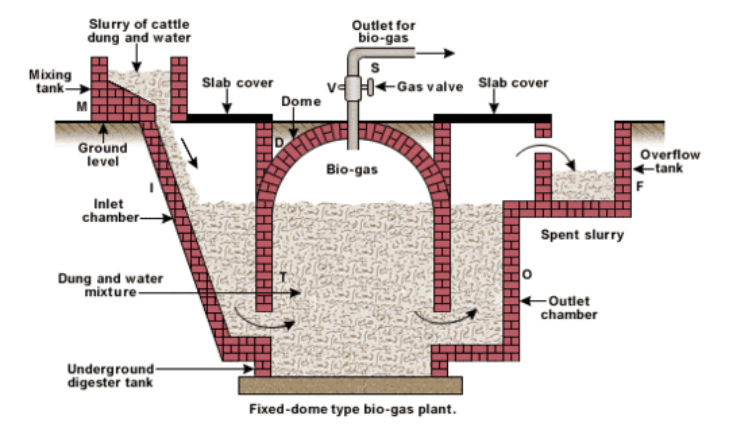
Explain the structure of a Biogas plant.
Answer
483.6k+ views
Hint: Biogas plant is a dome like structure, in which different rooms are present like, mixing tank, inlet chamber, outlet chamber, one digester and overflow chamber.
Complete answer:
Biogas basically is a gaseous mixture of gases produced by fermentation of different organic matter which involve household waste, domestic waste, animal waste, etc. This gas mainly consists of methane which is a result of metabolism of microorganisms feeding on the organic waste. So, we develop different and effective structures for biogas production.
Now, Biogas plants are somewhat, like dome structures. These are made up of bricks and cement. This is a sample diagram of a Biogas plant.

This plant consists of different chambers or rooms:
> Mixing tank – This tank is present above the ground where all waste is collected and everything collected is mixed to be processed further.
> Inlet chamber- This basically consists of two parts inlet pipe and storage place where inlet pipe will collect all the waste from mixing chamber.
> Digester- This tank is present underground so that proper anaerobic conditions can be provided to microbes to grow and to produce desired output. In this tank an outlet pipe is also connected which takes out gas which is produced inside.
> Outlet chamber – this tank is required to collect all dead biomass or remaining fragments of input waste. It took out all the waste from the digester.
> Overflow tank – Outlet chamber opens in a small overflow tank where all processed or waste material can be stored.
So, this was all about structure and a little bit about the function of each part of the Biogas plant.
Note: Biogas typically refers to a mixture of different gases produced by the breakdown of organic matter in the absence of oxygen. Mixing tan and overflow chambers are present above the ground and digesters where microorganisms grow, are present deep inside the ground.
Complete answer:
Biogas basically is a gaseous mixture of gases produced by fermentation of different organic matter which involve household waste, domestic waste, animal waste, etc. This gas mainly consists of methane which is a result of metabolism of microorganisms feeding on the organic waste. So, we develop different and effective structures for biogas production.
Now, Biogas plants are somewhat, like dome structures. These are made up of bricks and cement. This is a sample diagram of a Biogas plant.

This plant consists of different chambers or rooms:
> Mixing tank – This tank is present above the ground where all waste is collected and everything collected is mixed to be processed further.
> Inlet chamber- This basically consists of two parts inlet pipe and storage place where inlet pipe will collect all the waste from mixing chamber.
> Digester- This tank is present underground so that proper anaerobic conditions can be provided to microbes to grow and to produce desired output. In this tank an outlet pipe is also connected which takes out gas which is produced inside.
> Outlet chamber – this tank is required to collect all dead biomass or remaining fragments of input waste. It took out all the waste from the digester.
> Overflow tank – Outlet chamber opens in a small overflow tank where all processed or waste material can be stored.
So, this was all about structure and a little bit about the function of each part of the Biogas plant.
Note: Biogas typically refers to a mixture of different gases produced by the breakdown of organic matter in the absence of oxygen. Mixing tan and overflow chambers are present above the ground and digesters where microorganisms grow, are present deep inside the ground.
Recently Updated Pages
Glucose when reduced with HI and red Phosphorus gives class 11 chemistry CBSE

The highest possible oxidation states of Uranium and class 11 chemistry CBSE

Find the value of x if the mode of the following data class 11 maths CBSE

Which of the following can be used in the Friedel Crafts class 11 chemistry CBSE

A sphere of mass 40 kg is attracted by a second sphere class 11 physics CBSE

Statement I Reactivity of aluminium decreases when class 11 chemistry CBSE

Trending doubts
10 examples of friction in our daily life

The correct order of melting point of 14th group elements class 11 chemistry CBSE

Difference Between Prokaryotic Cells and Eukaryotic Cells

One Metric ton is equal to kg A 10000 B 1000 C 100 class 11 physics CBSE

State and prove Bernoullis theorem class 11 physics CBSE

What organs are located on the left side of your body class 11 biology CBSE




